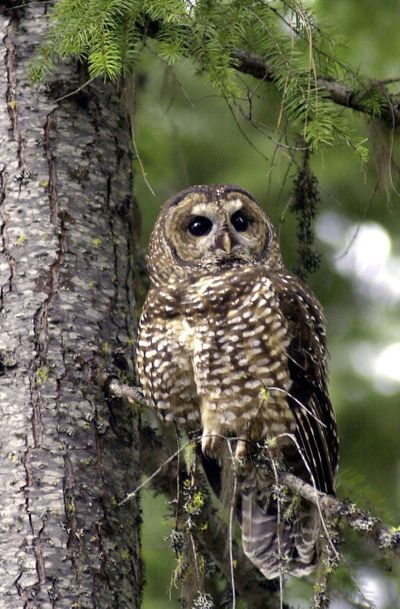Bullets may be used to save spotted owl
Population in steady decline; plan targets rival barred owl

PORTLAND – The federal government on Thursday unveiled the latest version of its plan to save the northern spotted owl, while acknowledging that the Pacific Northwest bird’s population is declining faster than scientists had previously thought.
The plan gingerly approaches the idea that government would experiment with shooting a rival bird, the barred owl. Some scientists say that species from the eastern U.S. has followed Americans westward over the decades and is now shoving the spotted owl aside.
The spotted owl is a smaller, meeker bird that was listed as threatened in 1990 because the old-growth forests it inhabits have been largely logged over.
Now the bird is losing out to the barred owl in remnant old-growth stands, federal officials said Thursday.
“This is the pressing short-term threat to the spotted owl,” said Robyn Thorson, northwest regional director of the U.S. Fish and Wildlife Service.
Although estimates of spotted owl numbers are considered inexact, ranging from a few thousand to 10,000, Thorson said studies of sample populations show them declining at an annual rate of 3 percent.
The barred owl is not in jeopardy and is instead expanding its range into California.
The plan that Thorson and other federal agency managers unveiled Thursday is the Obama administration’s attempt to find a lasting balance between saving the spotted owl from extinction and allowing logging on Northwest national forests – something neither the Clinton nor Bush administrations could do.
Initial reactions to the new plan suggested that it changed little in the long struggle over the forests the owl has come to symbolize: The timber industry says the plan doesn’t allow enough logging, and environmentalists say it allows too much.
The recovery plan doesn’t specify how to stem the barred owl’s invasion. One idea has been to select test areas, shoot barred owls to thin their numbers, and see whether spotted owls move back in. Alternatives include capturing them for removal or managing the forest habitat to encourage the birds to find separate niches.
An environmental assessment due in the fall is expected to spell out possible actions, and a decision to kill barred owls could generate opposition.
The Humane Society of the United States is skeptical of the idea, said wildlife scientist Stephanie Boyles. She said the scientific underpinnings are sketchy, the toll of as many as 3,000 birds over six to 10 years too high, and the results possibly futile.
“You’re going to have barred owls coming in to replace the ones that have been killed,” she said.
Steve Holmer, senior policy adviser at the American Bird Conservancy, said, however, that the Fish and Wildlife Service had done a thoughtful job in talking through the barred owl removal experiments as a means of preserving a species in danger.
“I think they were wise to get the bird conservation on board, and I think they were successful at that,” Holmer said.
Also due this fall is another component of spotted owl recovery: designating areas of “critical habitat” under terms of the Endangered Species Act.
The new plan includes a computer model designed to help biologists evaluate the effects of logging and forest thinning on spotted owl habitat, so protection for the bird can evolve over time and in the face of changing conditions.
The spotted owl has long been an emblem of the wrenching changes in the Northwest over the decline of the timber industry. Lumber mills were already closing for lack of logs and competing sources of lumber, and jobs were declining from automation when protections for the owl went into force.